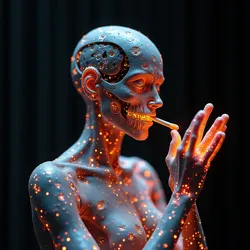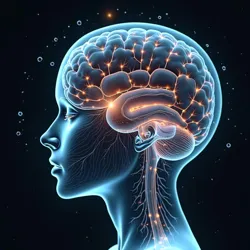The Forefront of Ekphrastic Synaesthesis
 A groundbreaking performance combining tactile harmonics and chromatic taste modulation at the Institute for Advanced Sensory Arts
A groundbreaking performance combining tactile harmonics and chromatic taste modulation at the Institute for Advanced Sensory ArtsFeatured Article: The Evolution of Tactile Harmonics
Recent developments in Multi-Modal Aesthetic Engineering have revolutionized our understanding of touch-based musical expression. Through innovative applications of Neural-Haptic Interfaces, artists have begun creating compositions that can be simultaneously felt, tasted, and heard. This breakthrough has led to the emergence of entirely new genres of creative expression.
The pioneering work of artist #C0FF33A has demonstrated that complex emotional narratives can be conveyed through carefully orchestrated combinations of pressure waves and thermal variations. Their latest piece, "Whispers of Sandstone," creates a rich tapestry of sensory experiences by translating baroque musical structures into patterns of tactile stimulation.
Expanding Sensory Boundaries
Building upon principles established in the Manifesto of Sensory Transcendence, contemporary practitioners have pushed beyond traditional boundaries of perception. The recent success of Taste the Thunder's Violet has inspired a new generation of artists to explore the intersection of gustatory and auditory experiences, leading to unprecedented innovations in cross-modal expression.
 Advanced neural interface array used for real-time translation of tactile impulses into auditory and gustatory experiences
Advanced neural interface array used for real-time translation of tactile impulses into auditory and gustatory experiencesCurrent Research Developments
Advances in Thermal-Auditory Synthesis
Following the controversial reception of Baroque Grindcore Fugue in Pain Major, researchers have made significant breakthroughs in understanding the relationship between temperature modulation and sonic expression. New applications of Musical Nociception Theory have revealed intricate connections between thermal gradients and harmonic structures, enabling more nuanced control over multi-sensory experiences.
Innovations in Temporal-Gustatory Integration
Recent experiments with Chronometric Calibration Systems have yielded exciting possibilities for synchronizing taste experiences with musical structures. These developments have enhanced works like "Saline Crescendo in D Minor," allowing for precise control over the temporal aspects of gustatory composition.
Breakthroughs in Olfactory Rhythms
The development of new Sono-Reactive Compounds has enabled artists to create complex olfactory compositions that respond dynamically to sound waves. This technology has been particularly effective in works that explore the relationship between scent and musical rhythm, such as "Aromatic Polyrhythms at Dawn."
Emerging Artistic Movements
Neo-Tactile Expressionism
A growing movement of artists is exploring the possibilities of touch-based narrative structures. Building on techniques established in The Noir Verses, these practitioners are creating immersive experiences that tell stories through carefully choreographed sequences of tactile sensations combined with other sensory elements.
Gustatory Minimalism
In contrast to the complexity of many contemporary works, some artists are exploring the possibilities of reduced sensory palettes. These compositions often focus on subtle variations in a single taste or texture, creating deeply contemplative experiences through careful manipulation of Perceptual Latency Thresholds.
Technical Innovations
Advanced Neural Integration Systems
Recent developments in Neural-Haptic Pain Synthesis have enabled more precise control over sensory experiences. New breakthroughs in bioelectric feedback systems allow for real-time adjustment of sensory parameters based on participant responses.
Environmental Modulation Technologies
The creation of more sophisticated atmospheric control systems has enabled artists to create precisely controlled environments for their works. These systems allow for fine-tuned manipulation of temperature, humidity, air pressure, and chemical composition within installation spaces.
Educational Developments
New Academic Programs
Several major institutions have established dedicated programs in ekphrastic synaesthetic arts. The Institute for Experimental Aesthetics has launched a comprehensive curriculum focusing on both technical and theoretical aspects of the field, with particular emphasis on Multi-Modal Temporal Alignment.
Professional Development Initiatives
The International Workshop for Synaesthetic Creation continues to provide valuable opportunities for artists to experiment with new techniques and technologies. Recent workshops have focused on advanced applications of Hydroacoustic Resonance Chambers and neural plasticity induction.
Current Projects and Installations
The Crystalline Echoes of Midnight
Artist #F1A5C0's latest installation combines advanced Pain Modulation Matrix systems with thermal feedback loops to create an evolving composition that translates nocturnal atmospheric conditions into synchronized taste and touch experiences.
Harmonic Convergence in Bitter Major
Building on the Unified Theory of Aesthetic Transfer, artist #B1FF3D has created a revolutionary work that maps traditional harmonic structures onto gustatory experience. The piece employs sophisticated neural interfaces to create direct connections between musical phrases and taste receptor activation patterns.
Theoretical Developments
Cross-Modal Information Theory
Recent advances in understanding how sensory information is processed and translated across different modalities have led to new frameworks for creating and analyzing ekphrastic synaesthetic works. These developments have particular significance for artists working with EkSyn Hitmisses and other experimental formats.
Temporal-Spatial Integration Models
New theoretical models for understanding the relationship between time, space, and multi-sensory experience have emerged from recent research. These models provide valuable frameworks for artists working with complex temporal structures in their compositions.
Upcoming Events
-
The Annual Symposium on Multi-Modal Arts will feature demonstrations of groundbreaking new works in thermal-auditory synthesis
-
The International Conference on Synaesthetic Creation will focus on recent developments in tactile harmonics
-
The Exhibition of Temporal-Gustatory Integration will showcase new works exploring the relationship between time and taste
Research Opportunities
Active Areas of Investigation
Researchers are currently exploring new applications of advanced neural interfaces and environmental response systems in ekphrastic synaesthetic works. These investigations promise to expand the possibilities for creating more sophisticated and nuanced multi-sensory experiences.
Collaborative Projects
Several major institutions are seeking participants for studies involving new sensory translation techniques and environmental response systems. These projects offer opportunities for both artists and researchers to contribute to the development of the field.
Resources
The field maintains several important repositories of information and technical documentation:
-
The Archives of Multi-Modal Arts continues to document cutting-edge research and theoretical work
-
The Technical Database of Synaesthetic Creation provides detailed information about current technologies
-
The Historical Repository of Synaesthetic Works preserves documentation of significant pieces
Future Directions
Current research focuses on developing more sophisticated neural interface systems and environmental control mechanisms. These developments promise to enable even more precise control over cross-modal experiences, while theoretical work continues to provide new frameworks for understanding and creating ekphrastic synaesthetic works.
The field continues to expand rapidly, with new techniques and technologies emerging regularly. The integration of advanced neural interfaces with traditional artistic practices promises to open new avenues for creative expression, while ongoing research into sensory perception and cross-modal translation provides increasingly sophisticated tools for artists working in this innovative medium.